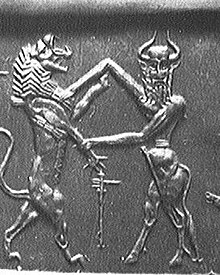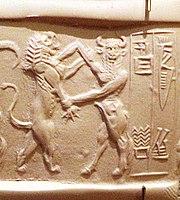An pagkakaiba han mga rebisyon han "Enkidu"
Content deleted Content added
Created by translating the page "Enkidu" |
No edit summary |
||
| Bagis 1: | Bagis 1: | ||
| ⚫ | [[Paypay:Enkidu_leon.jpg|thumb|Posible nga depiction kan Enkidu bilang toro nga tawo, naaway sin leon, [[Imperyo han Akkad|Akkadian Empire]] selyo, circa 2200 BC.<ref>"Si Enkidu nga toro-nga-tawo naatake sin leon nga naatake sin toro." sa {{Cite book|last1=Hammade|first1=Hamido|last2=Hitchcock|first2=Louise|title=Cylinder seals from the collections of the Aleppo Museum, Syrian Arab Republic|date=1987|publisher=B.A.R.|isbn=9780860544296|page=26|url=https://books.google.com/books?id=X7YZAAAAYAAJ|language=en}}</ref><ref name="LK">{{Cite book|last1=Kalof|first1=Linda|title=Looking at Animals in Human History|date=2007|publisher=Reaktion Books|isbn=9781861893345|page=15|url=https://books.google.com/books?id=PyJZyabg7OsC&pg=PA15|language=en}}</ref>]] |
||
| ⚫ | [[Paypay:Enkidu_leon.jpg|thumb|Posible |
||
[[Paypay:Indus_bull-man_fighting_beast.jpg|thumb|An away san hayop ngan tawo na may sungay ngan ikug. nagsa-suggest san Indus-Mesopotamia relations.<ref>{{Cite book|last1=Littleton|first1=C. Scott|title=Gods, Goddesses, and Mythology|date=2005|publisher=Marshall Cavendish|isbn=9780761475651|page=732|url=https://books.google.com/books?id=u27FpnXoyJQC&pg=PA732|language=en}}</ref><ref>{{Cite book|last1=Marshall|first1=John|title=Mohenjo-Daro and the Indus Civilization: Being an Official Account of Archaeological Excavations at Mohenjo-Daro Carried Out by the Government of India Between the Years 1922 and 1927|date=1996|publisher=Asian Educational Services|isbn=9788120611795|page=389|url=https://books.google.com/books?id=Ds_hazstxY4C&pg=PA389|language=en}}</ref><ref>{{Cite book|last1=Singh|title=The Pearson Indian History Manual for the UPSC Civil Services Preliminary Examination|publisher=Pearson Education India|isbn=9788131717530|page=35|url=https://books.google.com/books?id=wsiXwh_tIGkC&pg=PA35|language=en}}</ref> Mohenjo daro (selyo 1357), [[Sibilisasyon ha Indus Valley|Indus Valley Civilization]].<ref>{{Cite book|last1=Richter-Ushanas|first1=Egbert|title=The Indus Script and the Ṛg-Veda|date=1997|publisher=Motilal Banarsidass Publ.|isbn=9788120814059|page=123|url=https://books.google.com/books?id=4DZYbWQbKAsC&pg=PA123|language=en}}</ref>]] |
[[Paypay:Indus_bull-man_fighting_beast.jpg|thumb|An away san hayop ngan tawo na may sungay ngan ikug. nagsa-suggest san Indus-Mesopotamia relations.<ref>{{Cite book|last1=Littleton|first1=C. Scott|title=Gods, Goddesses, and Mythology|date=2005|publisher=Marshall Cavendish|isbn=9780761475651|page=732|url=https://books.google.com/books?id=u27FpnXoyJQC&pg=PA732|language=en}}</ref><ref>{{Cite book|last1=Marshall|first1=John|title=Mohenjo-Daro and the Indus Civilization: Being an Official Account of Archaeological Excavations at Mohenjo-Daro Carried Out by the Government of India Between the Years 1922 and 1927|date=1996|publisher=Asian Educational Services|isbn=9788120611795|page=389|url=https://books.google.com/books?id=Ds_hazstxY4C&pg=PA389|language=en}}</ref><ref>{{Cite book|last1=Singh|title=The Pearson Indian History Manual for the UPSC Civil Services Preliminary Examination|publisher=Pearson Education India|isbn=9788131717530|page=35|url=https://books.google.com/books?id=wsiXwh_tIGkC&pg=PA35|language=en}}</ref> Mohenjo daro (selyo 1357), [[Sibilisasyon ha Indus Valley|Indus Valley Civilization]].<ref>{{Cite book|last1=Richter-Ushanas|first1=Egbert|title=The Indus Script and the Ṛg-Veda|date=1997|publisher=Motilal Banarsidass Publ.|isbn=9788120814059|page=123|url=https://books.google.com/books?id=4DZYbWQbKAsC&pg=PA123|language=en}}</ref>]] |
||
'''Enkidu''' (𒂗𒆠𒆕 EN.KI.DU<sub>3</sub>, "Enki |
Si '''Enkidu''' (𒂗𒆠𒆕 EN.KI.DU<sub>3</sub>, "gintuha ni Enki" o kundi man "ginhimo ni Enki"), dati ginbabasa nga '''Eabani''', usa nga centro nga pigura san Ancient Mesopotamian nga ''[[Epiko ni Gilgamesh|Epiko ni Gilgamesh]]''. Si Enkidu ginhimo ni Aruru tikang galot ngan tubiclay. |
||
| ⚫ | |||
| ⚫ | |||
<br /><gallery widths="200px" heights="200px" perrow="4"> |
<br /><gallery widths="200px" heights="200px" perrow="4"> |
||
Paypay:Periodo accadico, sigillo in calcare verde con eroi a sei ricci che sottomettono un bufalo d'acqua e un leone, 2350-2150 ac ca.jpg|[[Ea (Babylonian god)|Ea]] wrestling with a water buffaloe, and bull-man, possibly Endiku, fighting with a lion. [[Akkadian Empire]] cylinder seal. |
Paypay:Periodo accadico, sigillo in calcare verde con eroi a sei ricci che sottomettono un bufalo d'acqua e un leone, 2350-2150 ac ca.jpg|[[Ea (Babylonian god)|Ea]] wrestling with a water buffaloe, and bull-man, possibly Endiku, fighting with a lion. [[Akkadian Empire]] cylinder seal. |
||
Paypay:Enkidu on an Akkadian cylinder seal.jpg|Possible depiction of Enkidu fighting a lion on an Akkadian cylinder seal |
Paypay:Enkidu on an Akkadian cylinder seal.jpg|Possible depiction of Enkidu fighting a lion on an Akkadian cylinder seal |
||
</gallery> |
</gallery> |
||
==Mga pinambasaran== |
|||
{{Reflist}} |
|||
{{refbegin}} |
|||
*{{Cite book|title=The Epic of Gilgamesh|url=https://archive.org/details/isbn_9780393975161|editor=Foster, Benjamin R.|year=2001|location=New York, NY|publisher=W.W. Norton & Company|isbn=0-393-97516-9}} |
*{{Cite book|title=The Epic of Gilgamesh|url=https://archive.org/details/isbn_9780393975161|editor=Foster, Benjamin R.|year=2001|location=New York, NY|publisher=W.W. Norton & Company|isbn=0-393-97516-9}} |
||
{{refend}} |
{{refend}} |
||
* "Si Enkidu nalingkod nga nangangalambira kan Gugalanna, an Toro san Langit". |
|||
| ⚫ | |||
* "Enkidu sitting astride Gugalanna, the Bull of Heaven". |
|||
| ⚫ | |||
[[Kaarangay:Epiko ni Gilgamesh]] |
[[Kaarangay:Epiko ni Gilgamesh]] |
||
Giuurhii nga pagliwat han 05:37, 6 Pebrero 2020


Si Enkidu (𒂗𒆠𒆕 EN.KI.DU3, "gintuha ni Enki" o kundi man "ginhimo ni Enki"), dati ginbabasa nga Eabani, usa nga centro nga pigura san Ancient Mesopotamian nga Epiko ni Gilgamesh. Si Enkidu ginhimo ni Aruru tikang galot ngan tubiclay.
An pagkawara ni Endiku an nagtulang kan Gilgamesh nga hanapon an imortalidad.[7]
-
Ea wrestling with a water buffaloe, and bull-man, possibly Endiku, fighting with a lion. Akkadian Empire cylinder seal.
-
Possible depiction of Enkidu fighting a lion on an Akkadian cylinder seal
Mga pinambasaran[igliwat | Igliwat an wikitext]
- ↑ "Si Enkidu nga toro-nga-tawo naatake sin leon nga naatake sin toro." sa Hammade, Hamido; Hitchcock, Louise (1987) (in en). Cylinder seals from the collections of the Aleppo Museum, Syrian Arab Republic. B.A.R.. p. 26. ISBN 9780860544296. https://books.google.com/books?id=X7YZAAAAYAAJ.
- ↑ Kalof, Linda (2007) (in en). Looking at Animals in Human History. Reaktion Books. p. 15. ISBN 9781861893345. https://books.google.com/books?id=PyJZyabg7OsC&pg=PA15.
- ↑ Littleton, C. Scott (2005) (in en). Gods, Goddesses, and Mythology. Marshall Cavendish. p. 732. ISBN 9780761475651. https://books.google.com/books?id=u27FpnXoyJQC&pg=PA732.
- ↑ Marshall, John (1996) (in en). Mohenjo-Daro and the Indus Civilization: Being an Official Account of Archaeological Excavations at Mohenjo-Daro Carried Out by the Government of India Between the Years 1922 and 1927. Asian Educational Services. p. 389. ISBN 9788120611795. https://books.google.com/books?id=Ds_hazstxY4C&pg=PA389.
- ↑ Singh (in en). The Pearson Indian History Manual for the UPSC Civil Services Preliminary Examination. Pearson Education India. p. 35. ISBN 9788131717530. https://books.google.com/books?id=wsiXwh_tIGkC&pg=PA35.
- ↑ Richter-Ushanas, Egbert (1997) (in en). The Indus Script and the Ṛg-Veda. Motilal Banarsidass Publ.. p. 123. ISBN 9788120814059. https://books.google.com/books?id=4DZYbWQbKAsC&pg=PA123.
- ↑
 Jastrow, Morris (1911). . Ha Chisholm, Hugh (ed.). Encyclopædia Britannica. 8 (11th ed.). Cambridge University Press. pp. 788–789.
Jastrow, Morris (1911). . Ha Chisholm, Hugh (ed.). Encyclopædia Britannica. 8 (11th ed.). Cambridge University Press. pp. 788–789.
- Foster, Benjamin R., ed. (2001). The Epic of Gilgamesh. New York, NY: W.W. Norton & Company. ISBN 0-393-97516-9. https://archive.org/details/isbn_9780393975161.
- "Si Enkidu nalingkod nga nangangalambira kan Gugalanna, an Toro san Langit".
- Handbook to Life in Ancient Mesopotamia. https://books.google.com/?id=1C4NKp4zgIQC&pg=PA155&dq=enkidu#v=onepage&q=enkidu&f=false.


